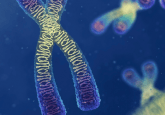Long live the women: study uncovers an explanation for the lifespan gap between sexes

New research has suggested that having two copies of the same sex chromosome offers protection and consequentially leads to a longer lifespan.
Differences in lifespan between the sexes have been observed in many different species, though not always in the same direction. In mammals, females tend to outlive males, whilst in birds the opposite is true. Although a popular theory has labeled risky male behavior as the cause in humans, new research has suggested that it may have more to do with our sex chromosomes.
In a new study, published in Biology Letters, a research team from The University of New South Wales Sydney (Australia) tested the ‘unguarded X hypothesis’, which suggests that the reduced or absent sex chromosome (e.g. Y chromosome in mammals or W chromosome in birds) in the heterogametic sex fails to protect an individual from deleterious mutations on the other sex chromosome.
Although this theory is by no means novel, all previous support has been anecdotal and exclusively observed in mammals and birds. This study was the first to put the hypothesis to a broad test, significantly expanding the phylogenetic span by compiling and analyzing female and male longevity data for 229 species across 99 families, 38 orders and eight classes of the tree of life.
“We looked at lifespan data in not just primates, other mammals and birds, but also reptiles, fish, amphibians, arachnids, cockroaches, grasshoppers, beetles, butterflies and moths among others,” explained first author, Zoe Xirocostas.
Female brains found to appear over 3 years younger than male brains, highlighting the difference between male and female brain, and potentially helping to explain why women tend to maintain cognitive function for longer.
The meta-analysis revealed that, across a broad range of species, the homogametic sex lives, on average, 17.6% longer than the heterogametic sex. Whilst this discovery provides support for the unguarded X hypothesis, the researchers also identified substantial differences in the lifespan dimorphism between female heterogametic species and male heterogametic species.
In species where females have two of the same sex chromosomes (e.g. humans and all other mammals), females live on average 20.9% longer than males. However, in species where males have the two sex chromosomes (e.g. birds, butterflies and moths), males only outlive females by 7.1%.
This finding suggests that, whilst sex chromosomes may play a role, there may still be something fundamentally life-shortening about being male. The researchers suggested that increased degradation of the Y chromosome, the protective value of estrogen or risky male behavior during sexual selection could be responsible for this trend.
“I was only expecting to see a pattern of the homogametic sex (XX or ZZ) living longer, so it came as an interesting surprise to see that the type of sex determination system (XX/XY or ZZ/ZW) could also play a role in an organism’s longevity,” Xirocostas remarked.
Although this study provides the vital, first evidence to support the unguarded X hypothesis, the results only suggest a correlation and further studies are needed to validate the findings. This is important as understanding the mechanism of longevity may lead to a deeper understanding of aging and eventually point to solutions to extend human lifespans.
 Keeping women young
Keeping women young

